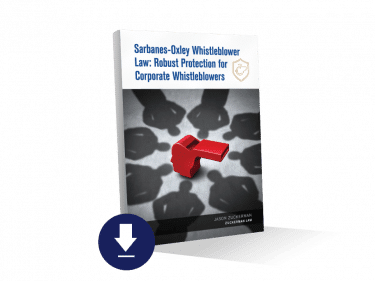Elements of a Sarbanes-Oxley Whistleblower Retaliation Claim
To prevail, a Sarbanes-Oxley Whistleblower must prove by a preponderance of the evidence that:
- they engaged in SOX protected activity (they made a protected disclosure under Section 806);
- the employer knew that they engaged in the protected activity;
- they suffered an unfavorable personnel action (retaliation);
- the protected activity was a contributing factor in the unfavorable action.
Once a SOX whistleblower has proven these elements by a preponderance of the evidence, the burden is on the employer to prove by clear and convincing evidence that it would have taken the same adverse action in the absence of the employee engaging in protected activity.
If you have suffered retaliation for whistleblowing, contact our experienced SOX whistleblower retaliation lawyers today at 202-262-8959.

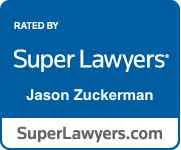

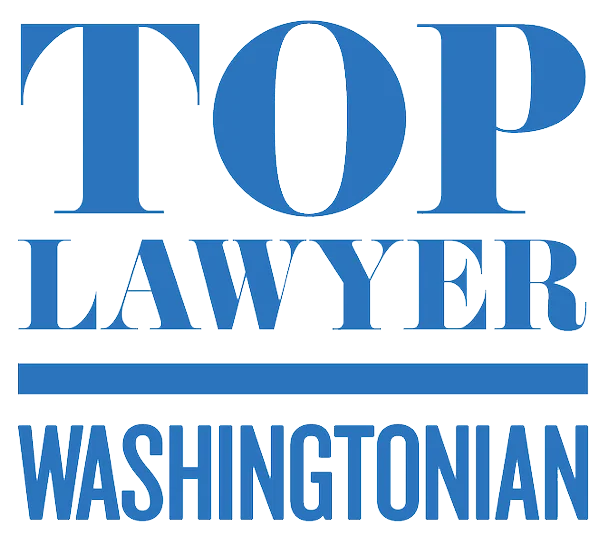
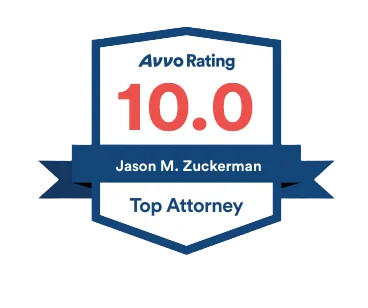
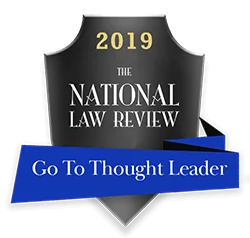
See our tips to get the maximum damages in your whistleblower retaliation case.
What is a whistleblower’s burden to prove retaliation under SOX?
A SOX whistleblower must demonstrate that their protected activity was a contributing factor in the decision to take an adverse action, i.e., that it was “more likely than not” played “any role whatsoever” in the allegedly retaliatory action.[i] And “any role whatsoever” is no exaggeration—the protected activity need not amount to a “significant, motivating, substantial or predominant” factor in the adverse action.[ii]
A whistleblower may meet this burden by proffering circumstantial evidence, such as:
- Direct evidence of retaliatory motive, i.e., “statements or acts that point toward a discriminatory motive for the adverse employment action.”[iii]
- Shifting or contradictory explanations for the adverse employment action.[iv]
- Evidence of after-the-fact explanations for the adverse employment action. “[T]he credibility of an employer’s after-the-fact reasons for firing an employee is diminished if these reasons were not given at the time of the initial discharge decision.”[v]
- Animus or anger towards the employee for engaging in a protected activity.
- Significant, unexplained or systematic deviations from established policies or practices, such as failing to apply a progressive discipline policy to the whistleblower.[vi]
- Singling out the whistleblower for extraordinary or unusually harsh disciplinary action.[vii]
- Disparate treatment or proof that employees who are situated similarly to the plaintiff, but who did not engage in protected conduct, received better treatment.
- Close temporal proximity between the employee’s protected conduct and the decision to take an actionable adverse employment action.
- Evidence that the employer conducted a biased or inadequate investigation of the whistleblower’s disclosures, including evidence that the person accused of misconduct controlled or heavily influenced the investigation.
- The cost of taking corrective action necessary to address the whistleblower’s disclosures and the decision-maker’s incentive to suppress or conceal the whistleblower’s concerns.
- Corporate culture and evidence of a pattern or practice of retaliating against whistleblowers.
If the whistleblower proves “contributing factor” causation by a preponderance of the evidence, then the burden shifts to the employer to prove clearly and convincingly that it would have taken the same adverse action in the absence of the employee’s engagement in protected activity.
In a mixed-motive case (where there is evidence of both a lawful and unlawful motive for the adverse action), does the evidence of a legitimate justification for the adverse action negate the whistleblower’s evidence that whistleblowing partially influenced the decision to take the adverse action?
A SOX whistleblower will typically prevail in a mixed-motive case because the SOX whistleblower’s burden is merely to show that protected activity played “any role whatsoever”—i.e., that it was a “contributing factor”—in the adverse employment action. If the decision-maker placed any weight whatsoever on the protected activity, then the whistleblower will establish causation.
The ARB has instructed ALJs to apply the following analysis in mixed-motive cases:
If the ALJ believes that the protected activity and the employer’s non-retaliatory reasons both played a role, the analysis is over and the employee prevails on the contributing-factor question. Thus, consideration of the employer’s non-retaliatory reasons at step one will effectively be premised on the employer pressing the factual theory that nonretaliatory reasons were the only reasons for its adverse action. Since the employee need only show that the retaliation played some role, the employee necessarily prevails at step one if there was more than one reason and one of those reasons was the protected activity.[viii]
[i] Palmer v. Canadian National Railway, ARB No. 16-035 at 53 (citations omitted).
[ii] Allen v. Stewart Enters., Inc., ARB Case No. 06-081, slip op. at 17 (U.S. Dep’t of Labor July 27, 2006).
[iii] William Dorsey, An Overview of Whistleblower Protection Claims at the United States Department of Labor, 26 J. Nat’l Ass’n Admin. L. Judiciary 43, 66 (Spring 2006) (citing Griffith v. City of Des Moines, 387 F.3d 733 (8th Cir. 2004)).
[iv] Clemmons v. Ameristar Airways, Inc., ARB No. 08-067, at 9, ALJ No. 2004-AIR-11 (ARB May 26, 2010) (footnotes omitted).
[v] Id. at 9-10 (footnotes omitted).
[vi] Bobreski v. J. Givoo Consultants, Inc., ARB No. 13-001, ALJ No. 2008-ERA-3 (ARB Aug. 29, 2014).
[vii] See Overall v. TVA, ARB Nos. 98-111 and 128, slip op. at 16-17 (Apr. 30, 2001), aff’d TVA v. DOL, 59 F. App’x 732 (6th Cir. 2003).
[viii] Palmer v. Canadian National Railway, ARB No. 16-035 at 56-57 (citations omitted).
At the Causation Stage, ALJs Should Not Weigh the Employer’s Non-Retaliatory Reasons Against the Employee’s Protected Activity
In Palmer, the ARB admonished ALJs not to weigh the relative importance of the protected activity and the employer’s non-retaliatory reasons when determining contributing factor causation. As discussed above, the contributing factor standard is met if the protected activity was only one of many reasons for the adverse action. The protected activity need play only some role, however small, in the decision. See id. at 55. It is therefore inconsequential if the non-retaliatory reasons were of great importance to the decisionmaker, while the protected activity had little weight. See id. Under the contributing factor standard, the only question to be answered is whether the decisionmaker placed any weight whatsoever on the protected activity. See id. If so, the whistleblower will establish causation.
Sarbanes-Oxley Whistleblower Retaliation
SOX Whistleblower Lawyer’s Guide to SOX Whistleblower Protection
Our leading whistleblower lawyers represent corporate whistleblowers in Sarbanes-Oxley whistleblower retaliation claims. To learn more about protections for corporate whistleblowers, download our free guide Sarbanes-Oxley Whistleblower Protection: Robust Protection for Corporate Whistleblowers.
Call us today for a free confidential consultation at 202-262-8959.
Zuckerman Law Amicus Curiae Filed on Behalf of Senator Wyden and Representative Speier Clarifying the Contributing Factor Causation Standard
In 2021, whistleblower protection law firm Zuckerman Law filed this amicus curiae brief concerning the appropriate causation standard under the SOX whistleblower protection law.
AMICUS CURIAE BRIEF OF SENATOR RON WYDEN AND REPRESENTATIVE JACKIE SPEIER AND IN SUPPORT OF THE PLAINTIFF-APPELLEE-CROSS-APPELLANTSOX Whistleblower Protection for SEC Whistleblowers
Experienced SOX Whistleblower Protection Lawyers






We have assembled a team of leading whistleblower lawyers to provide top-notch representation to Sarbanes-Oxley (SOX) whistleblowers. Recently Washingtonian magazine named two of our attorneys top whistleblower lawyers. U.S. News and Best Lawyers® have named Zuckerman Law a Tier 1 Law Firm in the Washington D.C. metropolitan area.
The whistleblower lawyers at Zuckerman Law have substantial experience litigating Sarbanes Oxley whistleblower retaliation claims and have achieved substantial recoveries for officers, executives, accountants, auditors, and other senior professionals. To schedule a free preliminary consultation, click here or call us at 202-262-8959. We represent whistleblowers nationwide.
- Matt Stock is a Certified Public Accountant, Certified Fraud Examiner and former KPMG external auditor. As an auditor, Stock developed an expertise in financial statement analysis and internal controls testing and fraud recognition. He uses his auditing experience to help IRS, CFTC and SEC whistleblowers investigate and disclose complex financial frauds to the government and develop a roadmap for the SEC to take an enforcement action. Matt has been interviewed on CNBC, quoted extensively about whistleblower rewards in the media, and is the lead author of SEC Whistleblower Program: Tips from SEC Whistleblower Attorneys to Maximize an SEC Whistleblower Award.
- Dallas Hammer has extensive experience representing whistleblowers in retaliation and rewards claims and has written extensively about cybersecurity whistleblowing. He was selected by his peers to be included in The Best Lawyers in America® in the category of employment law in 2021 and 2022.
- Described by the National Law Journal as a “leading whistleblower attorney,” founding Principal Jason Zuckerman has established precedent under a wide range of whistleblower protection laws and obtained substantial compensation for his clients and recoveries for the government in whistleblower rewards and whistleblower retaliation cases. He served on the Department of Labor’s Whistleblower Protection Advisory Committee, which makes recommendations to the Secretary of Labor to improve OSHA’s administration of federal whistleblower protection laws. Zuckerman also served as Senior Legal Advisor to the Special Counsel at the U.S. Office of Special Counsel, the federal agency charged with protecting whistleblowers in the federal government. At OSC, he oversaw investigations of whistleblower claims and obtained corrective action or relief for whistleblowers.
- Zuckerman was recognized by Washingtonian magazine as a “Top Whistleblower Lawyer” (2020, 2018, 2017, 2015, 2009, and 2007), selected by his peers to be included in The Best Lawyers in America® in the category of employment law (2011-2021) and in SuperLawyers in the category of labor and employment law (2012 and 2015-2021), is rated 10 out of 10 by Avvo, based largely on client reviews, and is rated AV Preeminent® by Martindale-Hubbell based on peer reviews
- We have published extensively on whistleblower rights and protections, and speak nationwide at seminars and continuing legal education conferences. We blog about new developments under whistleblower retaliation and rewards laws at the Whistleblower Protection Law and SEC Awards Blog, and in 2019, the National Law Review awarded Zuckerman its “Go-To Thought Leadership Award” for his analysis of developments in whistleblower law.
- Our attorneys have been quoted by and published articles in leading business, accounting, and legal periodicals, including The Wall Street Journal, Forbes, CNBC, MarketWatch, Vox, Accounting Today, Going Concern, Law360 – Expert Analysis, Investopedia, The National Law Review, inSecurities, Government Accountability Project, S&P Global Market Intelligence, Risk & Compliance Magazine, The D&O Diary, The Compliance and Ethics Blog, Compliance Week and other printed and electronic media.
Leading whistleblower law firm Zuckerman Law has written extensively about whistleblower protections and is quoted frequently in the media on this topic. A sample of those blog posts and articles appears below:
- Sarbanes Oxley Whistleblower Win Shows Strong Need For Whistleblower Protections
- DOL Adopts Strengthened Sarbanes-Oxley Whistleblower Regulations
- Jury Awards Former Bio-Rad Counsel $11M in Sarbanes-Oxley Whistleblower Case
- Sarbanes-Oxley Whistleblower Decision Clarifies Broad Scope of Protected Whistleblowing
- Decision Denying Motion for Summary Judgment Broadly Construes Sarbanes-Oxley Protected Whistleblowing
- Sarbanes-Oxley Protects Disclosures About Inadequate Information Security Controls
- Jury Awards Six Million Dollars to Whistleblower in Sarbanes-Oxley Case
- Sarbanes-Oxley Authorizes Damages for Reputational Harm
- OSHA Orders Bank to Reinstate Sarbanes-Oxley Whistleblower
- Sarbanes-Oxley Whistleblower Prevails on Appeal
- Sarbanes-Oxley Whistleblower Obtains $2.7M in Front Pay
- SOX Whistleblower Decision Adopts Favorable Pleading Standard for Whistleblowers
- OSHA Orders Wells Fargo to Pay $5.4M to Whistleblower
- District Court Rejects Materiality Requirement for Sarbanes-Oxley Whistleblower Actions
- SARBANES-OXLEY WHISTLEBLOWER CASE CLARIFIES THE BURDEN FOR PLEADING KNOWLEDGE OF PROTECTED WHISTLEBLOWING
- Whistleblowing Fraud Investigator Defeats Motion to Dismiss Sarbanes-Oxley Whistleblower Case
- Third Circuit Decision Highlights Key Procedural Distinctions Between Sarbanes-Oxley and Dodd-Frank Whistleblower Protection Provisions
- Federal Courts Are Adopting the Administrative Review Board’s Broad Interpretation of Sarbanes-Oxley Protected Conduct
- Are cybersecurity whistleblowers protected against retaliation?
- Court Rules that Whistleblowers Can Use Confidential Company Documents to Expose Fraud
- Fifth Circuit Holds that “Outing” a Whistleblower is an Adverse Action Under SOX
- Court Rules for In-House Counsel Whistleblower
- Leading SEC Whistleblower Law Firm Featured in Article About Growing Wave of Whistleblower Lawsuits
- Pro Se Sarbanes Oxley Whistleblower Prevails in Jury Trial
- Whistleblower Lawyer Interviewed About Dodd-Frank Whistleblower Protection Provision
- A Wells Fargo whistleblower warned about fake accounts in 2011 — nobody from the government ever spoke with her
- Whistleblower Lawyer Dallas Hammer Quoted About Cybersecurity Whistleblowing
- Tax Notes Quotes Whistleblower Lawyer Zuckerman About SOX Whistleblower Case
- Article Reports on Petition to Strengthen Whistleblower Rights
- Whistleblower Lawyer Zuckerman Quoted About OSHA Whistleblower Investigations
- Whistleblower Lawyer Quoted About Sarbanes-Oxley Whistleblower Development
- Whistleblower Lawyer Jason Zuckerman Quoted About Sarbanes-Oxley Whistleblower Protection
- Forbes Quotes Whistleblower Attorney Jason Zuckerman About Self-Help Discovery in Whistleblower Litigation
- Federal Courts Are Adopting the Administrative Review Board’s Broad Interpretation of Sarbanes-Oxley Protected Conduct
- DOL Clarifies Burden-Shifting Framework For Whistleblowers, Law 360 (October 2016)
- The Evolution Of SOX: A Powerful Remedy For Retaliation, Law 360 (May 2016)
- Whistleblower Protections and Incentives for Auditors and Accountants, Accounting Today (May 2016)
- 2016 Annual Update on the Whistleblower Provisions of SOX, American Bar Association Section of Labor and Employment Law Subcommittee on the Sarbanes-Oxley Act of 2002 (February 2016)
- Sixth Circuit Hands A Landmark Victory To SOX Whistleblowers, Law 360 (June 2015)
- A Year For Whistleblower Rewards And Protections, Law 360 (December 2014)
- Congress Strengthens Whistleblower Protections for Federal Employees, ABA Section of Labor and Employment Law (December 2012)
- Whistleblowers: What Protections And Forms of Relief Are Available For Foreign-Based Employees, ABA Section Of International Law Spring 2011 Meeting (March 2011)
- Law 360 Quotes Whistleblower Attorney Jason Zuckerman About Fifth Circuit Sarbanes-Oxley Whistleblower Decision
- Law 360 Quotes Whistleblower Lawyer Jason Zuckerman on Seminal Sarbanes-Oxley Whistleblower Decision
- Whistleblower Attorney Zuckerman Quoted in Article About Sarbanes-Oxley Whistleblower Protection Decisions
- Law 360 Quotes Whistleblower Lawyer Jason Zuckerman on Seminal Sarbanes-Oxley Whistleblower Decision
- Law360 Quotes Whistleblower Lawyer Jason Zuckerman About Sarbanes-Oxley Causation Standard
- Whistleblower Attorney Jason Zuckerman Quoted in Law360 Article About Whistleblower Self-Help Discovery
- Whistleblower Advocate Jason Zuckerman Quoted in Article About In-House Attorney Whistleblower Lawsuits
- Whistleblower Lawyer Hammer Quoted by Bloomberg About Rebound in Sarbanes Oxley Whistleblower Retaliation Claims
- Whistleblower Lawyer Quoted About Sarbanes-Oxley Whistleblower Development
- Whistleblower Lawyer Interviewed About the Rise of Cybersecurity Whistleblowing


